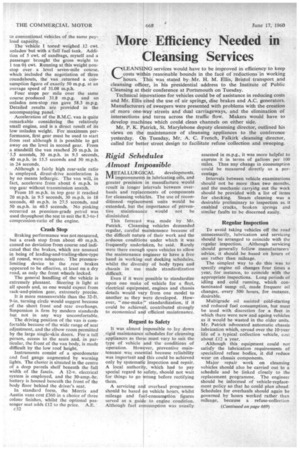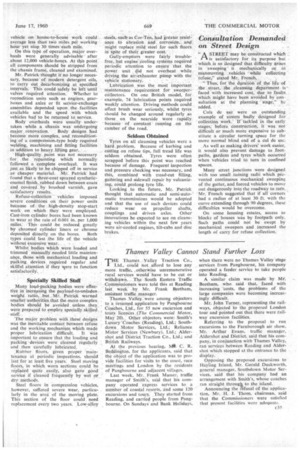More Efficiency Needed Cleansing Services
Page 68

Page 71

If you've noticed an error in this article please click here to report it so we can fix it.
CLEANSING services would have to be improved in efficiency to keep costs within reascinable bounds in the face of reductions in working hours. This was stated by Mr. H. M. Ellis, Bristol transport and cleansing officer, in his presidential address to the Institute of Public Cleansing at their conference at Portsmouth on Tuesday.
Technical innovations for vehicles could be of assistance in reducing costs and Mr. Ellis cited the use of air springs, disc brakes and A.C. generators. Manufacturers of sweepers were presented with problems with the creation of more one-way streets and dual carriageways, and the elimination of intersections and turns across the traffic flow. Makers would have to develop machines which could clean channels on either side.
Mr. P. K. Patrick, St. Marylebone deputy cleansing director, outlined his views on the maintenance of cleansing appliances to the conference yesterday. On Tuesday, Mr. A. C. French, Falkirk cleansing director, called for better street design to facilitate refuse collection and sweeping.
Rigid Schedules Almost Impossible
ikAETALLURGICAL developments, I VI improvements in lubricating oils, and greater precision in manufacture would result in longer intervals between overhauls and replacements of components for cleansing vehicles. The use of reconditioned replacement units would be extended, but the importance of preventive maintenance would not be diminished.
This forecast was made by Mr. Patrick. Cleansing vehicles demanded regular, careful maintenance because of the difficult nature of their work and the arduous conditions under which it was frequently undertaken, he said. Rarely were there enough spare vehicles to allow the maintenance engineer to have a free hand in working out docking schedules, whilst the diversity of body types and chassis in use made standardization difficult.
Even if it were possible to standardize upon one make of vehicle for a fleet, electrical equipment, engines and chassis details would vary from one model to another as they were developed. However, " one-make " standardization, if it could be achieved, contributed strongly to economical and efficient maintenance.
Regard to Safety It was almost impossible to lay down rigid maintenance schedules for cleansing appliances as these must vary to suit the type of vehicle and the conditions of operation. However, preventive maintenance was essential because reliability was important and this could be achieved only by systematic inspection and repair. A local authority, which had to pay special regard to safety, should not wait for things to go wrong before rectifying them.
A servicing and overhaul programme should be based on vehicle hours, whilst mileage and fulel-consurnption figures served as a guide to engine condition. Although fuel consumption was usually
assessed in m.p.g., it was more helpful to express it in terms of gallons per 100 miles. Thus any change in consumption could be measured directly as a percentage.
Intervals between vehicle examinations should not be more than two months, and the mechanic carryirlg out the work should be provided with a list of items for checking. Steam cleaning was a desirable preliminary to inspection as it enabled cracks, broken springs and similar faults to be discerned easily.
Regular Inspection
To avoid taking vehicles off the road unnecessarily, lubrication and servicing should be arranged to coincide with the regular inspection. Although servicing should generally follow manufacturers' advice, it should be based on hours of use rather than mileage.
The simplest way to do this was to specify engine oil changes four times a year, for instance, to coincide with the appropriate inspections. Long periods of idling and cold running, which contaminated sump oil, made frequent oil changes, every 500 hours, for instance, desirable.
Multigrade oil assisted cold-starting and reduced fuel consumption, but must be used with discretion for a fleet in which there were new and ageing vehicles as it would be wasted in the older units. Mr. Patrick advocated automatic chassis lubrication which, spread over the 10-year life of a typical collection vehicle, cost about £12 a year.
Although this equipment could not satisfy the lubrication requirements of specialized refuse bodies, it did reduce wear on chassis components.
Major repair work on cleansing vehicles should also be carried out to a schedule and be linked closely to the replacement programme. The engineer should be informed of vehicle-replacement policy so that he could plan ahead. Schedules for overhauls should again be governed by hours worked rather than mileage, because a refuse-collection vehicle on house-to-house • work could average leis than two miles pek working hour yet stop 30 timeveach mile.
On this type of operation, major overhauls were generally advisable after about 12,000 vehicle-hours. At this point: all components should be stripped from the 'chassis frame, cleaned and examined.
Mr. Patrick -'thought it no longer necessary, because of modern detergent oils, to carry Out decarbonizing at specified intervals. This could safely be left until valves required attention. Whether tO recondition units such as engines, gearboxes and axles or fit service-exchange assemblies depended upon the facilities available and the speed with which vehicles had to be returned io service.
Body • overhauls were usually undertaken• while a chassis was undergoing major, renovation. . Body designs had become more complex, and reconditioning of a compression-type body required welding, machining and fitting facilities in addition to heavy, lifting gear.. .
High-quality paint was not necessary for the repainting which normally followed a complete overhaul. It was just as likely to be chipped off in service . as cheaper material. Mr. Patrick had found that a three-coat sprayed syntheticenamel finish, rubbed down between coats and covered _by brushed varnish, gave satisfactory . results.
Refuse-collection vehicles imposed severe conditions on their power unitS because of -the high-density stOp-start work on which they were employed. Cast-iron cylinder bores .had been known to wear at the rate of 0.001 in.. per 1,000 Thiscould be reduced, greatly by chromed cylinder liners or chrome
deposited directly. on the bores. Both types could last the life of the vehicle without excessive wear. .
Whilst bodies which were loaded and trimmed -manually needed little maintenance,, those with mechanical loading and pecking devices required regular and skilful attention if they nere to function satisfactorily. .
Specially Skilled Staff Many !Gad-packing bodieswere effeetiVe in inereasing the payload-to7uola4en weight. ratio, .but Mr. Patrick warned srtraller authorities, that the more complex, . bedies should be avoided . unless, they. were' prepared lei employ specially skilled, 'The major problem with•these designs was the inevitable contact between refuse and the working .mechartism Which made proper lubrication difficult. It Was important to ensure that the loading and packing devices were cleaned regularly and then carefully .lubricated. :Rubber floors, given proper 'maintenance at periodic inspections, should last for at least five years. Steel moving floors, in which. worn sections could be replaced quite .easily, also. gave ,good service if cleaned frequently by wet or
dry' methods. .
Steel floors in compression vehicles, however, suffered severe wear, particularly in the area of the moving plate. This section of the floor could . peed replacement every two years. .Low-alloy
• steel,sue as Cor-Ten, had 'greater resist.: anee to abrasion and corrosion, and: might -replaCe mild steel for such floors
in Spite of their greater cost. •
Gully-emptiers were fairly troublefree, tent engine' cooling systems required periodic attention to ensure that the power unit . did not overheat while driving the air7exhauster pomp with the
vehicle stationary.
Lubrication Was the most important maintenance requirement for .sweepercollectors. On one British model, for exainple, 74 lubrication points 'required weekly attention. Driving methods could affect brush wear seriously, whilst tyres should be changed around regularly as those on the nearside wore rapidly because of constant running on the camber of the road.
Seldom Obtained
Tyres on all cleansing vehicles were a hard problem. Because of kerbing and cutting on refuse tips, full tread life was seldom obtained. Tyres were often scrapped before this point was reached because of damage. Frequent inspection and pressure checking was necessary, and this, combined with tread-cut filling, gaitering and sidewall repair by vulcanizing, could prolong tyre life.
Looking to the future, Mr. Patrick thought that automatic and setni-automatic transmissions would be adopted and that the use of such devices could reduce wear on propeller shafts, couplings and driven axles. Other innovations he expected to see on cleansing vehicles within the next few years were air-cooled engines, tilt-cabs and disc brakes.
Consultation Demanded on Street Design
"A STREET may be constructed which is satisfactory for its purpose but • which is so .designed that difficulty arises in 'sweeping' it Mechanically or_ in manceuvring ...vehicles -while collecting refuse," stated Mr, French.
"Thus, for. 'the dnration. of the life of the street, :the ,eleansing department. is faced with increased cost, due to .faults. which. might have been avoided by consultation at the planning • stage,'.'.
added. • ' Cuts de sac were an outstanding example of streets, badly 'designed for colleetion work.' If tackled in the early stages; before construction, it was nor difficult or much more expensive to substitute a circular turning space for the more normal blind end of a cut de sac.
As well as making drivers' work easier, it would also prevent damage to .footpaths, gardens and tyres which occurred when vehicles tried to turn in confined spaces.
Many street junctions were designed with too small turning radii which prevented continuous mechanical sweeping of the gutter, and forced vehicles to move out dangerously into the roadway to.turn.. Mr. French suggested that if all "corners s had a radius of at least 30 ft. with the curve extending through 90 degrees, these difficulties would be overcome.
On some housing estates, access to blocks of houses was by footpath only. Such paths could not he swept by mechanical sweepers and increased the length of carry for refuse collection.
























































































































